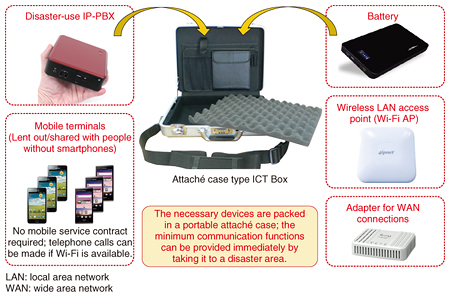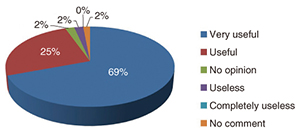 |
|||||
|
|
|||||
|
Feature Articles: Movable and Deployable ICT Resource Unit—Architecture for Quickly Responding to Unexpected ICT Demand Vol. 13, No. 5, pp. 23–26, May 2015. https://doi.org/10.53829/ntr201505fa5 ICT Service for MDRUsAbstractIn this article, we describe an Internet protocol (IP) phone service system and an evacuee management system that were developed as information and communication technology (ICT) services for Movable and Deployable ICT Resource Units (MDRUs) to assist in recovery after large-scale disasters. Deploying an MDRU with IP-PBX (IP-based private branch exchange) functionality to the affected areas makes it possible to immediately provide IP phone services via Wi-Fi. The evacuee management system proposed here enables the efficient collection of evacuee data in evacuation centers. Keywords: phone service, IP-PBX, evacuee management system 1. IP phone service for disaster reliefThe proposed Internet protocol (IP) phone system employs an extended IP-based private branch exchange (IP-PBX) system that is installed in the Movable and Deployable information and communication technology (ICT) Resource Unit (MDRU). The IP phone system is expected to be used for emergency communication by local governments and residents at evacuation centers when telecommunication services are disrupted for an extended period of time after a large-scale disaster [1]. The features of the system allow quick and convenient startup of the phone service. Voice calls can be made using Wi-Fi with smartphones, tablets, or computers. Users can make voice calls immediately simply by registering the telephone number of the terminal they are using. Calls can be made and received with the mobile or landline telephone number normally used. Users can download the application to his/her smartphone from the server in the MDRU. The IP phone application on a smartphone is shown in Fig. 1. Tapping the icon on the Disaster Phone application automatically triggers the registration and enables immediate voice calling. The phone is connected to and configured by NTT’s FLET’S HIKARI DENWA phone service router, after which calls can be made to, and received from, outside lines.
We also developed a prototype of an attaché case type MDRU (ICT Box), in which the functions necessary for specific services are modularized to improve portability [1]. The ICT Box, which holds the module implementing the proposed IP phone service system, is shown in Fig. 2. It consists of a small IP-PBX, mobile battery, Wi-Fi access point, and a VoIP (voice over IP) adapter, all placed within an attaché case. We conducted an experiment and confirmed that the 18,000-mAh mobile battery enabled the portable MDRU to operate for 5 hours, during which time 140 calls were placed. The offered service and ICT resources are limited with this device, but its portability is excellent.
2. Evacuee management systemThe evacuee management system was also developed as an ICT service essential for recovering from large-scale disasters. It allows data on people affected by the disaster to be rapidly gathered. The features and advantages of the system are shown in Fig. 3.
The unified management of data is possible by giving each person an IC card with a unique identification (ID); this ensures seamless data handling regardless of whether people are moved from evacuation centers to temporary housing. Accurate management of people by associating facial photographs and personal information (name, age, gender, address, etc.) is also possible. Moreover, it offers questionnaire and statistical analysis functions that make it possible to learn about evacuation center conditions and to find out current requirements in real time. When the portable IP phone system using the attaché case prototype is connected to the Internet, it is possible to provide the collected data to the “J-anpi [2]” service operated by NTT Resonant Inc. 3. Subjective evaluation experimentWe conducted a subjective evaluation experiment of the IP phone service in cooperation with the University of Aizu during a campus festival held in October 2013. A photograph of this event is shown in Fig. 4. About 300 men and women ranging in age from their teens to their 70s participated. They were asked to evaluate the service’s effectiveness on a 5-level scale. The results of the subjective evaluation are shown in Fig. 5. As shown in the figure, more than 95% of evaluators ranked the service as useful or very useful.
We also conducted a subjective evaluation experiment of the evacuee management system. At the Tohoku Section Joint Convention of the Institutes of Electrical and Information Engineers, Japan, held August 22–23, 2013 at the University of Aizu, a conference area was made into an evacuation center, and assessment tests were conducted to determine how quickly the participant information database could be created and the collected information utilized. Around 200 of the 500 conference attendees participated in the experiment. The functions of the evacuee management system were assessed through surveys and briefings. The result was that more than 80% of evaluators ranked the system as useful or very useful during a disaster. 4. ConclusionWe proposed an emergency IP phone service system and an evacuee management system to assist MDRUs in recovering from a large-scale disaster. The systems can be installed in a variety of MDRU units that will be transported to the damaged area after a disaster occurs. Prototype systems were developed, and subjective evaluations were performed. The evaluation results confirmed the effectiveness and feasibility of our proposed system. AcknowledgmentsPart of the work in this article is being conducted under the national projects, R&D on the reconfigurable communication resource unit for disaster recovery and R&D of “Movable ICT Units” for emergency transportation into disaster-affected areas and multi-unit connection, both supported by the Ministry of Internal Affairs and Communications of Japan. The authors would like to express their appreciation to the project members from Tohoku University and Fujitsu Corporation for their collaboration. References
|
|||||
















